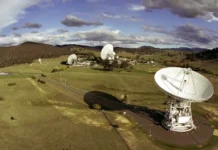SpaceX Successfully Launches 30 Satellites on Dedicated Rideshare Mission
In a remarkable feat of engineering and space exploration, SpaceX launched 30 satellites on December 21, 2024, as part of its second dedicated rideshare mission to mid-inclination orbits. This mission, known as Bandwagon-2, further solidifies SpaceX’s status as a leader in the commercial space industry.
The launch took place at 6:34 a.m. Eastern Time from Vandenberg Space Force Base in California. The Falcon 9 rocket, which is renowned for its reliability and reusability, was used for this mission. Impressively, the first stage of the Falcon 9, making its 21st flight, successfully returned to the launch site just 8 minutes and 15 seconds after liftoff, while the second stage continued its journey to deploy the satellites.
Mission Details and Payloads
SpaceX, staying consistent with its usual practice, did not provide detailed information about the deployment sequence of the 30 satellites. However, over the following hours, several of the satellites’ operators confirmed successful communication with their newly deployed assets.
Key Payloads and Their Missions
The most significant payload on the Bandwagon-2 mission was the third reconnaissance satellite for the South Korean military, part of the "425 Project." This satellite series is aimed at enhancing the military’s surveillance capabilities. The first satellite in this series was launched on a Falcon 9 in December of the previous year, followed by the second on the Bandwagon-1 mission in April.
In addition to the South Korean military satellite, several other notable payloads were on board:
- HawkEye 360: This company deployed three satellites, known as Cluster 11, for radio-frequency intelligence. These satellites are equipped with advanced payloads designed to collect and transmit data to ground stations, enhancing their capability to monitor and analyze radio frequency signals across the globe.
- Iceye: The Finnish company launched two synthetic aperture radar (SAR) satellites capable of providing radar imagery with a resolution of 25 centimeters. This technology is crucial for applications such as environmental monitoring, mapping, and disaster response. Iceye has now successfully launched a total of 40 satellites, including nine this year alone.
- Other Participants: The mission also included payloads from companies like Sidus Space, Tomorrow.io, True Anomaly, and Think Orbital. These companies are emerging players in the space industry, each with unique missions and goals, ranging from weather forecasting to innovative orbital technologies.
Several rideshare aggregators facilitated the participation of these companies, with Exolaunch being responsible for 22 of the payloads on this mission. Rideshare aggregators play a critical role in ensuring that smaller satellites can hitch a ride to space, reducing costs and increasing access to space for a wider range of entities.
The Bandwagon Series: A Versatile Solution
SpaceX announced the Bandwagon line of rideshare missions in 2023 to complement its existing Transporter series, which is dedicated to sun-synchronous orbits. The Bandwagon missions are designed to cater to the growing demand for mid-inclination orbits, which are the second most requested orbit type after sun-synchronous. These missions provide a versatile and cost-effective solution for launching a diverse array of satellites.
SpaceX has already planned two more Bandwagon missions for 2024 and another two for 2025. However, the company has not yet committed to additional Bandwagon missions beyond that timeframe. The flexibility and adaptability of the Bandwagon missions are part of SpaceX’s strategy to meet the evolving needs of its customers and the broader space industry.
Increasing Launch Ambitions
The Bandwagon-2 mission marks the 130th launch of SpaceX’s Falcon rockets in 2024, a significant increase from the 96 launches conducted in 2023. Despite this impressive growth, SpaceX will not reach its ambitious goal of 148 launches set earlier in the year.
Gwynne Shotwell, the president and chief operating officer of SpaceX, acknowledged this shortfall during a Center for Strategic and International Studies event on December 17. She explained that the original goal for 2024 was 144 launches, but the company added four additional launches to compensate for those not completed in 2023. These "absurdly ambitious" goals, as she described them, are part of SpaceX’s strategy to combat conservatism and risk aversion within the company.
Shotwell emphasized the importance of setting high targets to keep the team motivated and focused. "It really keeps you on your toes," she said. "We wanted to launch 148 times this year. We’re not going to get there, but we’re fighting for every last launch. We really want it to be 136. Hopefully, it is. And, man, the Falcon team is fighting for that."
Looking ahead to 2025, SpaceX plans to raise its ambitions even further, with a target of 175 to 180 launches. This relentless push to increase the launch rate is supported by innovations such as faster turnaround times for droneships, which recover the rocket boosters. By reducing the time spent in port from days to just a few hours, SpaceX can quickly prepare for the next launch.
Conclusion: A Testament to Innovation
The successful launch of the Bandwagon-2 mission is yet another testament to SpaceX’s innovative approach and its commitment to pushing the boundaries of what is possible in the commercial space industry. By providing flexible and cost-effective solutions like the Bandwagon series, SpaceX continues to democratize access to space, enabling a diverse range of customers to achieve their missions.
As SpaceX looks toward the future with ever-increasing launch goals, it remains clear that the company is driven by a relentless pursuit of excellence and a vision to make space more accessible to all. With each successful mission, SpaceX not only advances its own goals but also contributes to the broader advancement of human knowledge and capabilities in space exploration.
For more detailed information and updates on SpaceX’s missions, visit the original article at SpaceNews.
For more Information, Refer to this article.


































